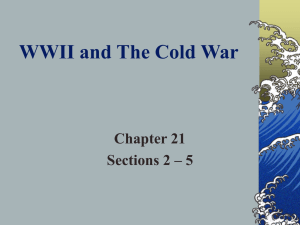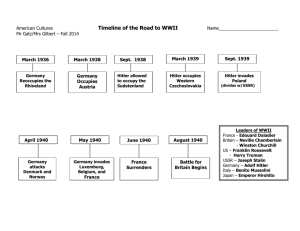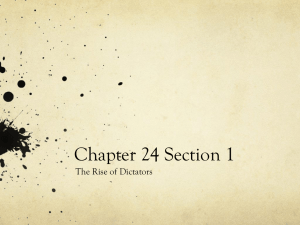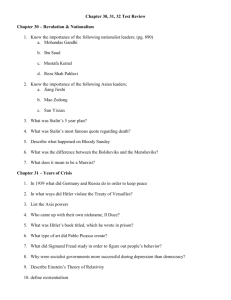Test Review (Part 1)
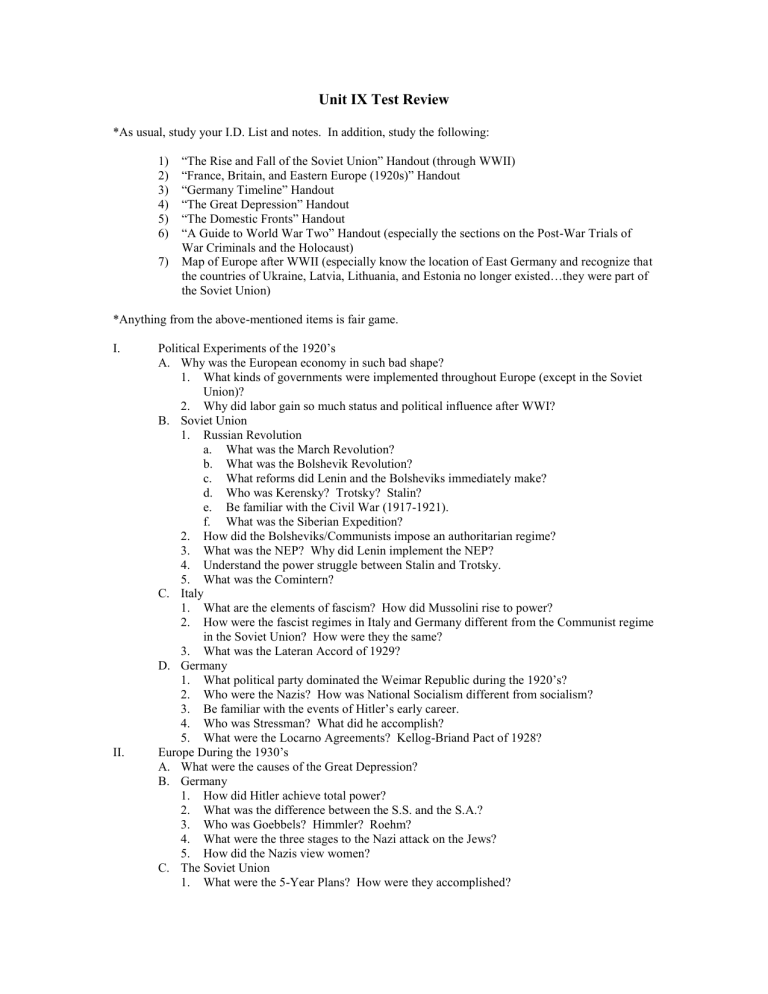
Unit IX Test Review
*As usual, study your I.D. List and notes. In addition, study the following:
1) “The Rise and Fall of the Soviet Union” Handout (through WWII)
2) “France, Britain, and Eastern Europe (1920s)” Handout
3) “Germany Timeline” Handout
4) “The Great Depression” Handout
5) “The Domestic Fronts” Handout
6)
“A Guide to World War Two” Handout (especially the sections on the Post-War Trials of
War Criminals and the Holocaust)
7) Map of Europe after WWII (especially know the location of East Germany and recognize that the countries of Ukraine, Latvia, Lithuania, and Estonia no longer existed…they were part of the Soviet Union)
*Anything from the above-mentioned items is fair game.
I.
Political Experiments of the 1920’s
A.
Why was the European economy in such bad shape?
1.
What kinds of governments were implemented throughout Europe (except in the Soviet
Union)?
2.
Why did labor gain so much status and political influence after WWI?
B.
Soviet Union
1.
Russian Revolution a.
What was the March Revolution? b.
What was the Bolshevik Revolution? c.
What reforms did Lenin and the Bolsheviks immediately make? d.
Who was Kerensky? Trotsky? Stalin? e.
Be familiar with the Civil War (1917-1921). f.
What was the Siberian Expedition?
2.
How did the Bolsheviks/Communists impose an authoritarian regime?
3.
What was the NEP? Why did Lenin implement the NEP?
4.
Understand the power struggle between Stalin and Trotsky.
5.
What was the Comintern?
C.
Italy
1.
What are the elements of fascism? How did Mussolini rise to power?
2.
How were the fascist regimes in Italy and Germany different from the Communist regime in the Soviet Union? How were they the same?
3.
What was the Lateran Accord of 1929?
II.
D.
Germany
1.
What political party dominated the Weimar Republic during the 1920’s?
2.
Who were the Nazis? How was National Socialism different from socialism?
3.
Be familiar with the events of Hitler’s early career.
4.
Who was Stressman? What did he accomplish?
5.
What were the Locarno Agreements? Kellog-Briand Pact of 1928?
Europe During the 1930’s
A.
What were the causes of the Great Depression?
B.
Germany
1.
How did Hitler achieve total power?
2.
What was the difference between the S.S. and the S.A.?
3.
Who was Goebbels? Himmler? Roehm?
4.
What were the three stages to the Nazi attack on the Jews?
5.
How did the Nazis view women?
C.
The Soviet Union
1.
What were the 5-Year Plans? How were they accomplished?
2.
What is collectivization?
3.
Who were the Kulaks?
4.
What were the Purges of the mid to late-1930’s?
*Also, know the following:
--Totalitarianism
--Cult of Personality
III.
Again the Road to War
A.
What is appeasement? What is the Munich Conference?
B.
What were Hitler’s goals?
C.
Know the order of Hitler’s alliances and annexations.
D.
Why did Hitler lose respect for the Western Powers and the League of Nations?
E.
What was the significance of the Spanish Civil War (1936-1939)?
F.
What was the Nazi-Soviet Pact?
IV.
V.
World War II (1939-1942)
A.
From a Western perspective, what marks the beginning of WWII? Eastern or more global perspective?
B.
What was the blitzkrieg ?
C.
What was the “Phony War?”
D.
What was the Miracle of Dunkirk?
E.
What happened to France after it fell to the Germans in June of 1940?
F.
What was the significance of the Battle of Britain?
1.
Who was Winston Churchill?
2.
Why do some historians believe that Hitler did not seriously try to invade Britain?
G.
What was Operation Barbarosa?
1.
Why did Hitler wait until June to launch his invasion of Russia?
2.
Why did Hitler decide to invade Russia?
D.
What was Hitler’s plan for Europe?
1.
What is “Germanization”?
2.
What was the Holocaust? Final Solution?
World War II (1942-1945)
VI.
A.
What was the Greater East Asia Co-Prosperity Sphere?
B.
Why did the Japanese attack Pearl Harbor?
1.
Did Hitler know?
2.
Did Roosevelt know?
3.
Who said, “Thank God, the war is won.”
C.
What was the turning point in the Pacific?
D.
What was the turning point in North Africa?
1.
What was the “soft underbelly” of Nazi Europe?
2.
What was the second front?
E.
What was the turning point in Europe?
F.
What was strategic bombing?
G.
What is D-Day? The Battle of the Bulge?
H.
When was V-E Day?
I.
What is “island hopping”?
J.
When was V-J Day?
K.
Why did the United States drop Atomic Bombs on Hiroshima and Nagasaki?
Preparations for Peace
A.
Be familiar with the wartime conferences and what was decided at each.
B.
What did the U.S. and the Allies do differently after WWII (compared to what they did after
WWI)?



